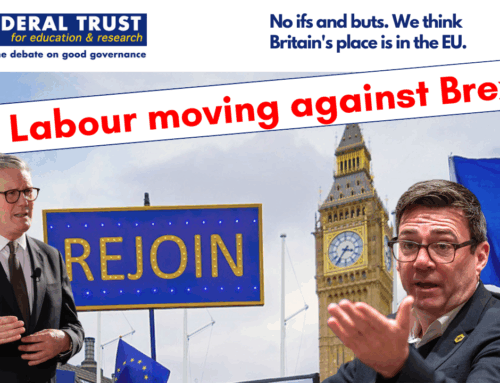In Scotland, there is a real sense of its politics and the constitutional debate moving into a new phase as the aftermath of the pro-independence SNP and Green parties’ success in the elections sinks in. Turnout, at 63%, was the highest it has been since the first elections to the parliament in 1999. The combined seats of 64 SNP MSPs and 8 Green MSPs gives a pro-independence block of 72 seats in a parliament of 129 MSPs. And both SNP and Green parties stood on a clear platform of holding another independence referendum.
These results could, even so, be seen as more of the same. The SNP got 1 more seat than in 2016, the Greens 2 more, the Tories remain on 31 seats while Labour lost 2. And the constitutional stand-off remains. Nicola Sturgeon was swift to press home her message that there was a clear and democratic mandate for another referendum. And Michael Gove toured the TV studios on the Sunday with the basic message that Theresa May also used in 2017 – now is not the time. Gove was keen to emphasise the UK is a voluntary union, Scotland could choose to leave. Yet the Tory stance is clearly the opposite of open or flexible.
But this does not look like a simple ground-hog day repeat of the constitutional tensions since the Brexit vote in 2016. Much has changed in the last five years. The UK has now left the EU, with the UK government’s negotiation of a basic trade and cooperation deal with the EU making it a very hard Brexit, whose damaging and negative impacts have started to be very clearly seen and felt since the start of 2021.
So where may Scotland’s politics go next and how will the pressures towards the UK’s fragmentation unfold?
Impact of the Scottish Elections
After four consecutive wins in the Scottish parliament elections, the SNP’s position – and that of First Minister Nicola Sturgeon – looks strong indeed. The Tories have attempted to make much of the SNP getting 64 not 65 seats, so not an actual majority, despite the SNP forming the government again and the joint SNP-Green majority being 15. Yet the political mood, as reflected in Scottish, much of UK and a wide swathe of EU media, is rather clear that there is a democratic mandate (and in the wake of Brexit) to have another independence vote.
The political dynamics now are different to four or five years ago too. The last Scottish parliament elections in 2016 were just before the EU referendum, where England and Wales’ leave majorities overwhelmed Scotland’s and Northern Ireland’s remain vote. Nicola Sturgeon called for another independence referendum, in March 2017, given the substantial change of Brexit since the 2014 vote. Theresa May refused, now was not the time – and then called her ill-fated general election that lost the Tories their majority but also cut the SNP’s MPs from 56 to 35, dampening the drive for another independence vote.
The SNP bounced back to win 48 seats in the 2019 general election and have now, with the Greens, won a clear majority for a second referendum. In that sense, the 2019 and 2021 Scottish results reinforce each other in a much more positive way than the Scottish government and SNP faced in the wake of its 2017 general election results and the absence of a clear ‘Brexit bounce’ for independence at that point. The 2021 election success also comes 15 months after the UK left the EU, and 4 months after the UK left the EU’s single market and customs union with the basic trade and cooperation agreement in place at the very last minute, allowing no time for preparations tailored to the specifics of that agreement. The damage and impact of Brexit is now very clear, obscured only in part by the impact of the Covid crisis.
There are uncertainties over how the fractious UK-EU relationship will evolve in the coming years. But the twin trade and withdrawal agreements are the clear structure for that relationship for now. Neither the May and Johnson governments took any steps to create a form of Brexit that might have been seen as a compromise between leave and remain, or to consult in any serious or substantial way at all the devolved governments. More than this, with the Internal Market Act, Johnson has ridden roughshod over the existing devolved powers settlement. All these Brexit and EU dynamics still play into Scottish politics.
Through all the dysfunctional, failing UK politics since the Brexit vote, there has been a fairly slow but clear shift of some Scottish ‘remain’ voters to back independence – adding about 5 percentage points to support for independence. The second half of 2020 then saw over 20 opinion polls in a row backing independence, only to fall back to around 50:50 in subsequent polling so far in 2021. This divide in the Scottish population is also reflected in last Thursday’s election results – voters split almost exactly 50:50 (when both constituency and list votes are taken into account) between pro- and anti-independence parties. Yet the strong, significant demographics of support for independence remain clear – with those under 50 or 55 years (depending on the poll) showing a majority for independence.
The Covid pandemic – both in its health and economic dimensions – as well as the dynamics of UK and Scottish politics are all intertwined in these shifting polls. Nicola Sturgeon has retained the confidence of a majority of Scottish voters in her management of the pandemic, whereas Johnson, in Scotland, clearly does not. But the impact of the rather successful vaccine roll-out, concerns over the economic impact of the Covid crisis, and the impact of the bitter Sturgeon-Salmond stand-off and the two related inquiries culminating in the early months of 2021, may have all contributed to the return of a 50:50 split on independence in current polls.
Salmond’s party, though, performed very badly in the election, winning no seats, to the relief, doubtless, of the SNP. The Tories strong performance in English council elections, and Labour’s disarray, also point to both the changing trends and divisions in England’s politics and the deep gap between Scottish and English political trends and culture. Both the pandemic and Brexit will pose major challenges ahead for UK and Scottish governments. But the political landscape for the Scottish government looks remarkably positive, in the wake of the elections, given both the turbulence of the last year and of the years since 2016.
Where Next?
Nicola Sturgeon insisted throughout the election that managing the pandemic would remain her top priority if she remained First Minister. The pandemic is the UK government’s priority too. And voters are not looking for another independence referendum until the pandemic is clearly past as a health crisis. But constitutional politics will not stay on hold, and arguments about the economics of recovery from Covid, and the relative impacts of Brexit and Covid, can all be expected to be a big part of the political mix looking ahead.
Some of the constitutional jousting has been clearly on display in the initial few days since the election. Nicola Sturgeon has emphasised she will ask for agreement to hold an independence referendum once the pandemic eases, looking at a referendum perhaps in 2023 or conceivably in 2022. Compared to a year ago, if Johnson refuses a section 30 order to enable the Scottish parliament to run a referendum, Sturgeon and the SNP have now much more firmly and publicly grasped the ‘plan B’ idea of passing a referendum bill through Holyrood to allow a vote to take place. Whether this is within Holyrood’s competence is a moot point: the union is reserved business but asking the opinion of the Scottish people on independence in what would be a non-binding referendum may be feasible.
On the various Sunday politics shows neither Sturgeon nor Gove wanted to take an ‘I’ll see you in court line’ – Gove claiming, rather vaguely, the UK government wasn’t going there, and Sturgeon insisting it would be a democratic outrage for the UK government to challenge such a vote if Holyrood had passed it. Meanwhile, Gove was trialling the rather corny-sounding ‘Team UK’ in fighting the pandemic, reinforced by Johnson writing to Sturgeon inviting her to a summit of the four UK nations on Covid.
Gove, notably, agreed with the BBC’s Andrew Marr that the UK union is a voluntary one and that Scotland could indeed leave through a legal referendum; the Tories are not going to be labelled immediately as running a coercive union if they can avoid it. But a continued ‘no’ to an independence vote in the next 2-3 years will start to look like exactly that – a non-voluntary union. And a move by the Scottish government to run an advisory referendum would surely indeed end up in the Supreme Court (and/or the UK government could pass legislation making such a referendum illegal).
Even if legal, some have suggested the pro-union side would not participate in such a vote. But if the Scottish parliament passes a constitutional and legal vote to hold such a referendum, backed by their 2021 democratic mandate, non-participation may look strange to voters indeed. And, under its new leader, Anas Sarwar, would Scottish – and UK – Labour refuse to take part in that vote, aligning themselves with the Tories in boycotting it? Sarwar, like Starmer, may talk the language of unity but he will soon have to add some serious policy positioning, including on a future referendum, to look credible and to distinguish Labour from the Tories in Scotland, not least given a substantial chunk of Scottish Labour voters support independence.
Boris Johnson will doubtless continue to suggest that now is not the time for a referendum and is unlikely to listen to pro-union voices suggesting a rapid referendum under strict conditions, while support is at 50:50 and the UK is funding the Covid recovery, could be a good move. So the political and constitutional stand-off between Scottish and UK governments looks set to sharpen strongly in the coming year.
Amidst these political arguments, the substantive case for and against independence can and has often been simply left out. The election campaign was notably focused more on the question of having or stopping a referendum than in any serious way on the pros and cons of independence – though some of the issues around independence in the EU and the question of a Scotland-England border did finally emerge. Nicola Sturgeon even admitted during the campaign that the economic case, to the extent it had been made by her government in the 2018 Growth Commission report, was now out of date. But she insisted that a full economic prospectus would be made in the run up to a referendum.
Yet both sides face a big risk going into a referendum where views on independence are split 50:50. And it is past time for the Scottish government to set out its full case for independence in the European Union – including the economic, political, social, and security issues. On Brexit day, at the end of January 2020, Sturgeon did promise a series of ‘New Scotland’ policy papers showing how Scotland could transition to becoming an independent country. That the pandemic pushed such work off-track is unsurprising but at the start of a new term of the Scottish parliament, this analysis must surely be done and placed in the public domain.
Some of the big substantive issues around independence are challenging. The UK-EU trade deal does mean a hard border between England and an independent Scotland in the EU, while creating an open Scotland-EU border – there are pros and cons here. Yet the path back to the EU itself looks relatively straightforward – and in the face of Brexit, EU governments are less likely to show the same sort of ‘helpful to the UK’ neutrality they demonstrated in 2014.
In the end, independence is about a series of transitions: a transition out of the UK to becoming, once again, an independent state; a transition into the European Union. Both of these transitions are feasible and they both have associated costs and benefits. Amidst the constitutional stand-off, and the big question of whether Scotland will indeed say yes to independence in the coming years, the debate sorely needs to get onto these substantive issues too.






The basic trade and cooperation agreement with the EU-27
has proved woefully insufficient for Britain’s needs.
It has reduced the supply of doctors, nurses, lorry drivers,
agricultural and hospitality workers, bringing pressure
and chaos to everyday life. It has hit or will damage exports and employment
in fishing, food, artistic and other services and it threatens
the peace in Ireland. Leaving the EU internal energy market
has doubled gas prices relative to the rest of Europe.
Promised genuinely new trade opportunities have vanished.
Understanding Brexit Options – http://www.sparklingbooks.com/gb.html – explains alternative relationships with
Europe. The detrimental effect on trade in both goods and services that has been caused
by leaving the single market was entirly foreseeable.
As the United Kingdom’s relationship with Europe
changes and evolves, the book documents better options that Britain needs
but are rejected by its politicians. E-book only 99p.
You may also be interested in a commentary by Professor Richard Rose, “UK Ministers have little incentive to prioritise Scotland”, see here: https://fedtrust.co.uk/uk-ministers-have-little-incentive-to-prioritise-scotland/
It seems to me that the SNP is going the wrong way about achieving independence. The principle reason for it should be that it’s the only way to rejoin the European single market and gain its benefits. Scotland should be moving its focus towards the rest of Europe and away from Westminster with visible signs such as EU flags and lapel badges and even adopting Kilometres and driving on the right. And why not start using the Euro in parallel with the Pound? These aren’t such crazy ideas if you want to align yourself with the EU but the Scots have to overcome their instinctive dourness first. It’s the only thing that’s holding them back.
We’ll explain the situation in Scotland. Sturgeon will be help by the Scottish voters to get that referendum; they, the Scottish people have the right to decide their future.
Sorry : “secession”
It could be argued that a referendum on Scotland secessation is of such historical importance that it should require a minimal quorum and yes vote to succeed( ie 2 thirds of the electorale and participants)
I hope journalists/commentators will set out a study of the mechanics of an independent Scotland. There is the long and seemingly unexamined land border. There is the nuclear arsenal. There is the electricity grid. And the longer it takes, the further Scotland will have to have drifted from EU law. How much administrative talent has Edinburgh? There is the euro. And if the UK one day rejoins the EU, would it all have seemed a waste of effort?
Although, in general, I think fragmentation is a less desirable outcome in a complex world, Scotland does not deserve to suffer under England’s Brexit disaster and they have a legitimate right to seek independence in Europe.